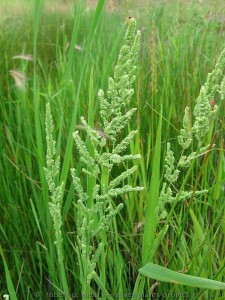American Sloughgrass
Beckmannia syzigachne
Description: Stout annual, stems solitary or a few to a clump.
Leaves: Soft, flat, with overlapping sheaths.
Inflorescence: Many 1-sided spikes in a narrow panicle, yellowish, with golden-brown seeds.
Height 2’3”
Ecology: Waterfowl readily eat the seeds of this species.
Growth Requirements: Sloughgrass will grow on loamy or clayey soils in marshy flats or wet meadows. It is slightly shade tolerant.
 Common Camas
Common Camas
Camassia quamash
Description: Perennial forb from large (up to 1.5″ across) egg-shaped bulbs.
Leaves: Basal, grass-like, linear.
Flowers: Blue to purple, star-shaped, about 2″ across, with 6 linear petals. Flowers sometimes single, more often in clusters.
Height: Up to 2′
Ecology: In the early spring camas foliage is eaten by deer, elk, and moose. Camas is shade intolerant, and is found in meadows and forest openings. It generally increases after fires, and many Northwest tribes regularly burned camas meadows for this reason. it also increases with some loosening or slight scarification of the soil.
Growth Requirements: Can be grown from either bulbs or seed, which should be covered with 1-2″ of mulch for best germination. Prefers sites that stay consistently wet in spring but dry out in summer or fall, and will grown in all soil types. Competition from grass inhibits seedling establishment.
Ethnography: Camas was arguably the most important plant food to many Northwest tribes, playing an important part in spiritual life as well as making up a major portion of their diet. Raw bulbs contain insulin, an indigestible sugar, which breaks down into fructose when cooked. The Canadian explorer David Thompson reported eating 36-year-old bulbs that still had flavor.
 Big-Leaf Sedge
Big-Leaf Sedge
Carex amplifolia
Description: The stems form alone or in small groups, forming long, stout, creeping rhizomes. Red-tinged near base, dry leaves from previous year present at base.
Leaves: 6-12 per plant, very broad, flat.
Inflorescence: Elongate, well-seperated, 3-7 spikes with leafy bracts.
Height: 2-4′.
Ecology: Grows under wet conditions in stream banks and meadow habitats. Often found growing in shadier sites than other sedges. Occurs at elevations from sea-level to 8000′.
Growth Requirements: Thrives in wet soils along woodland and prairie streams and in freshwater marshes.
Ethnobotany: Leaves woven to make spoons by Paiute Indians. Young stems eaten raw by Montana tribes.
 Water Sedge
Water Sedge
Carex aquatilis
Description: Grows in dense clumps from deeply buried cord-like rhizomes. Stems are red-tinged, surrounded by long, brown scales and old leaves.
Leaves: 8-15 per stem, erect, equal to or shorter than stem, with flat, bluish-green blades. Long, cylindrical, 3-7 per plant, with leaf-like sheaths.
Height: To 3′.
Water sedge equals clover in nutritional value and exceeds it in protein content, and is browsed by game and cattle. Waterfowl eat the seeds of water sedge, but they are probably not a major food source. It produces few seeds, and spreads mostly through rhizomes. Usually a dominant plant where it occurs.
Found in shallow water or immediately adjacent to streams or ponds. This species grows best on flat surfaces or slopes less than 10%. Due to its dense root system it is highly recommended for erosion control.
Ethnobotany: Water sedge is sometimes cut and baled for hay.
 Small-Winged Sedge
Small-Winged Sedge
Carex microptera
Description: Densely tufted, no rhizomes, triangular stems.
Leaves: 3-5 on the lower one-third of the stem, with flat, firm blades. Leaves much shorter than the stem.
Inflorescence: Round, brown head at tip of stem.
Height: to 2′.
Ecology: Common species of moist to wet places, from mid to high elevations.
Growth Requirements: Found in forested wetlands and wet meadows. Tolerates some dry soil.
Ethnobotany: Used as a ceremonial emetic by the Navajo. This plant is good for sheep browse.
 Nebraska Sedge
Nebraska Sedge
Carex nebrascensis
Description: Densely tufted, no rhizomes, triangular stems.
Leaves: 3-5 on the lower one-third of the stem, with flat, firm blades. Leaves much shorter than the stems.
Inflorescence: Round, brown head at tip of stem.
Height: To 2′.
Ecology: Natural occurrence in the Northwest is common. Good cover for nesting waterfowl and small mammals. Seeds and rhizomes eaten by waterfowl, upland game birds, small mammals and songbirds. The leaves feed muskrats, geese and other grazers.
Tolerant of salinity and alkalinity and a range of soil textures. Can tolerate total inundation for up to 3 months. One of the most drought tolerant sedges, growing along ponds and stream edges.
Ethnobotany: Due to the lack of strong grass species in their home region, the Nez Perce used many sedge species to make ropes and twine.
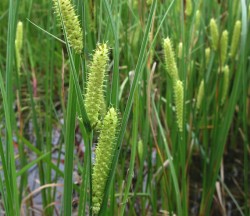 Beaked Sedge
Beaked Sedge
Carex rostrata
Description: Base of stem is light brown and spongy, conspicuously clothed with old, dense leaves. Extensive, stout, rhizomatous root system with short and long creeping runners, sometimes forming dense sod.
Leaves: Thick and flat, yellowish-green, upper leaves longer than stems.
Inflorescence: Distinctive large, dense, yellowish-green to straw-colored flower heads. Seeds have beaked tip.
Height: 2-4′.
This species is often dominant or co-dominant where it occurs. It can form a dense mat on stream banks, holding the banks together even when undercut, which forms excellent salmonid habitat. Spreads through rhizomes, fragmentation, stolons, and seed.
Growth Requirements: Tolerates acid, but not alkaline soils, and will grow in shade or sun but is less vigorous in shade. Will tolerate flowing and standing water. Grows best on gentle slopes, and sites that are wet most of the year.
Ethnobotany: Northwest native peoples sometimes used this sedge as a cleaning brush, and ate the fleshy leaf bases.
 Blister Sedge
Blister Sedge
Carex vesicaria
Grows in loose clumps, with triangular, slender, reclining, and slightly reddish stems that have a spongy base.
Leaves: 4-10, with flat blades.
Inflorescence: Several, erect, stalkless, yellowish to purple brown. Bracts well-developed and longer than seedhead.
Sometimes eaten by grazers. Spreads by seeds and rhizomes. Grows at low to mid elevations.
Growth Requirements: Tolerant of alkaline soils, and all soil textures. Generally found near still water, in wet meadows and along pond edges. Reportedly quite common historically on the Palouse in meadows with camas and Nebraska sedge.
Ethnobotany: Some sedges, especially those with relatively large leaves, were used by Northwest native peoples to line pit-ovens cache pits, moccasins, and berry baskets.
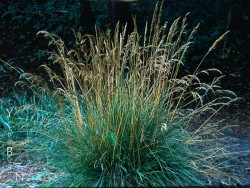 Tufted Hairgrass
Tufted Hairgrass
Deschampsia caespitosa
Description: Densely tufted perennial, with matted, dry leaves at base.
Leaves: Mostly basal, stiff, usually foled or inrolled, bright green.
Inflorescence: Loose, open, branched green or purplish clusters with a metallic sheen. 2-3 flowers per spikelet near branch tips. Erect or nodding heads.
Height: To 3′.
Big game and livestock browse this species, especially in spring and early summer before it matures. In some areas it is also important bear forage. While tolerant of some shade, it rarely occurs under a forest canopy. It is an aggressive colonizer, and occurs in climax communities.
Growth Requirements: A useful species for revegetating mine spoils because of its tolerance for acid soil, tufted hairgrass tolerates a wide range of moisture regimes but is most often found as an intermediary between sedge communities and upland sites. Can be seeded or planted as plugs. Seeding should be done in the fall.
On well-watered sites tufted hairgrass will often form a dense monoculture, which makes good hay.
 Creeping Spikerush
Creeping Spikerush
Elocharis palustris
Description: Perennial, often grows in dense stands, spreads through long, creeping rhizomes. Single-stemmed from base; round, light green.
Leaves: Basal, reduced to sheaths.
Inflorescence: Solitary, conical spikelet at end of stem, covered with brown overlapping scales.
Height: To 4′, but usually less than half that height.
Ecology: The cluster of seeds in the spike provides food for various species of ducks and geese, and the dense growth provides cover for small mammals, fish and waterfowl.
Growth Requirements: Prefers semi-permanently saturated or flooded conditions and is most often found in standing water. Tolerates up to 6 inches of water depth (maybe more), and alkaline soils. Shade tolerant.
Sap eaten by Northern Paiute Indians. Used as bedding, and for pillows by the Okanagan and Colville tribes.
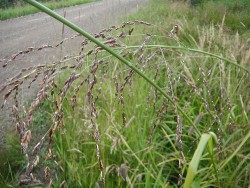 Western Mannagrass
Western Mannagrass
Glyceria occidental
Description: Perennial native emergent grass.
Leaves: Narrow, flat, ribbon-like, soft, smooth leaves.
Inflorescence: Open, loose.
Height: To 4.5′.
Found in shallow water of ponds, pools, lakes, and depressions of wet prairies, from sea level to 4500′.
Growth Requirements: Plant in fall or spring. Requires 18 or more inches of precipitation during the growing season. Moderate tolerance of salinity and acidity.
Ethnobotany: Provides food and cover for birds, including many water-fowl, and small seed-eating songbirds. Muskrats and small mammals eat mannagrass.
 Cow Parsnip
Cow Parsnip
Heracleum lanatum
Description: Tight clumps of white flowers blossoming from single stems that are soft, hairy, and hollow. Oval or heart-shaped seeds.
Leaves: 4-12″ long and wide, maple-like, coarsely toothed, with flowers 4-8″ wide.
Inflorescence: Small, white flowers clumped closely together.
Ecology: Deer, elk, moose, bear, and small mammals readily eat cow parsnip. It also provides excellent cover for songbirds and grouse. Reproduction is entirely by seed – or nearly so. There is some uncertainty as to whether cow parsnip reproduces vegetatively. Tends to grow in denser patches on wetter sites.
Growth Requirements: Cow parsnip tolerates a fairly broad range of site moisture, growing on the Palouse most commonly in creek bottoms in the floodplain, especially with aspen and hawthorn, but also on drier hillsides with only hawthorn. Is somewhat tolerant, but also grows in full sun. Plant seed in the fall.
Ethnobotany: Also known as Indian celery or Indian rhubarb, the stems of this species were (and are) highly valued as a vegetable. They must be peeled before eating, to remove the skin with its irritating hairs. Care should be taken to distinguish this species from the toxic poison hemlock (Conium maculatum), an exotic weed also found in creek bottoms on the Palouse.
 Wild Iris; Blue Flag; Rocky Mountain Iris
Wild Iris; Blue Flag; Rocky Mountain Iris
Iris missiouriensis
Description: Showy perennial from thick, spreading rhizomes.
Leaves: Basal, linear, sword-shaped, with parallel veination.
Inflorescence: The flowers are large, delicate, blue-violet, and often have purple veins.
Height: 1-2′.
Ecology: Iris flowers are attractive to hummingbirds and insects. Forms smalls but dense populations, spreading by seed and rhizomes. AS patches increase in size, the older central individuals often die.
Growth Requirements: Since this species flowers and goes dormant fairly early in the year, it will grow on sites that dry out by June or July. Wild iris was apparently very common historically on the Palouse, often growing in wet meadows with camas.
Ethnobotany: Used as a salve for toothaches by tribes of the Great Basin, and small amounts of the root can induce vomiting. The roots are poisonous. Fibers from the leaves make strong and flexible cordage, which was used for fishing nets and snares.
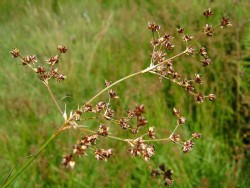 Jointed Rush
Jointed Rush
Juncus articulatus
Description: Stems form in both loose and dense clumps along rhizomes.
Inflorescence: Open, flowers originate on widely spreading terminal branches.
Leaves: Circular in cross-section, pulpy, and contain inside partitions (or joints).
Height: From 6-20″.
Ecology: Spreads vegetatively and from seed. Grows at low to mid elevations.
Tolerates a wide range of soil conditions, and grows along wetlands and streams. needs year-round soil moisture.
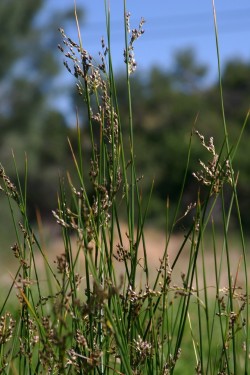 Baltic Rush
Baltic Rush
Juncus balticus
Description: Dark green, round stems that grow in loose clumps at the base and spread out.
Inflorescence: Brown cluster on side of stem.
Leaves: Basal, nearly bladeless, sheaths brown.
Height: 18-30″.
Ecology: Often found in saline or alkaline wetlands. Tolerates wide range of hydrologic conditions. Strong root system makes this plant ideal for streambank stabilization. Trends to increase with disturbance such as grazing.
Growth Requirements: Grows along pond and stream edges, on a wide range of seasonally-flooded, moist soils, but can also survive water tables 9′ or more below the surface.
Ethnobotany: Sugar, formed along the tops of the plants, was gathered and eaten as candy. Seeds used for food by the Paiute. Stems used for weaving baskets by some Montana tribes.
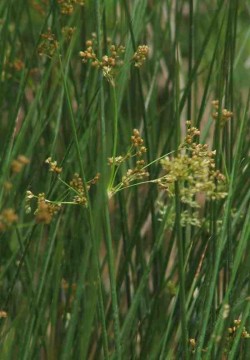 Common Rush; Soft Rush
Common Rush; Soft Rush
Juncus effusus
Description: Rhizomatious plant that grows in large clumps of several hundred stems, which are smooth, round, bright green, and hollow.
Inflorescence: A dense cluster that appears to originate directly from the stem.
Leaves: Reduced basal.
Ecology: Seeds from this species are eaten by many birds and small mammals, and the sense strands it forms provide cover for amphibians and fish. These dense stands and fibrous roots also make common rush good for sediment and nutrient filtration.
Growth Requirements: Prefers finely textured soil, and water less than 6″ deep, but tolerates a wide variety of site conditions. Won’t grow in sites that dry out for long periods of time.
Ethnobotany: Juncus stems are used in making coiled baskets by Southern California tribes. The Quinalt of Western Washington also used common rush for making baskets. They also mixed stems from this species with cattails to make string.
 Dagger-Leaf Rush
Dagger-Leaf Rush
Juncus ensifoltus
Description: Stems grow from a central point and gradually grow apart.
Inflorescence: Small, dense, and rounded flower heads growing at the end of each stem.
Leaves: Distinct, flattened sword-shaped, 1-3 per stem.
Inflorescence: Small, dense, rounded flower heads growing at the end of the stem.
Height: Short in stature, rarely more than 1 foot in height.
Fast growing bank stabilizer, re-sprouts quickly following disturbance. Found at elevations from 1,500 – 4,500′.
Growth Requirements: Rarely found in standing water, and tolerates seasonal drought. Appears to grow well on the Palouse in all types of soils. Plant in fall or spring. Needs at least 12 inches of precipitation during the growing season.
Ethnobotany: Bulbs are used as food by some Northwest peoples.
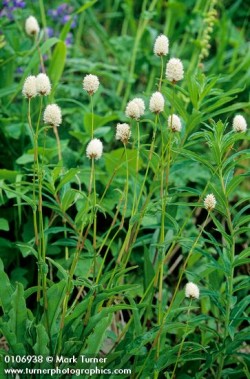 American Bistort
American Bistort
Polygonum bistortoides
Description: Perennial forb, rhizomatous, with stems reclining to around a height of 2.5′
Leaves: Basal, lance-shaped, 5-12″ long with long stalks. Stem leaves are much smaller and stalkless. Float on or just about the water surface.
Inflorescence: White or pinkish, in dense spike-like clusters.
Ecology: Reproduces through seed or roots through nodes. Provides food and cover for waterfowl and songbirds.
Growth Requirements: Shade intolerant, doesn’t like clay soils, or moving water. Grows in fresh water up to 10″ deep or in wet soils. Needs only seasonal saturation.
Ethnobotany: While the Nez Perce apparently used this species only occasionally, other tribes of the Northwest ate the starchy roots raw, in stews or soups, or ground into flour. The leaves and shoots are also edible, but the mature stems are tough.
 Wapato; Duck Potato
Wapato; Duck Potato
Sagittaria latifolia
Description: Semi-aquatic perennial, with tuber-bearing rhizomes.
Inflorescence: Flowering stalks leafless, flowers about 1″ across with three white petals.
Leaves: Large arrow-shaped leaves found on long talks that hold blades in or above water.
Height: To 1.5′.
Ecology: Waterfowl and muskrats eat the roots, shoots, and seeds. In dense stands, it also provides cover for fish and aquatic insects. This plant extracts large amounts of nutrients and metals from the water during the growing season.
Growth Requirements: While apparently not common on the Palouse historically, wapato grows well in shallow ponds in the area. It must be partially submerged part of the year, but will grow in ponds and wetlands that dry up in late spring.
Native Americans collected and baked the tubers. Tubers have a sweet taste similar to chestnuts. The Nez Perce considered wapato a highly desirable food, and traded for it since its occurrence was uncommon in their territory.
 Hardstem Bulrush
Hardstem Bulrush
Scirpus acutus
Description: Round-stemmed plant with dark green rigid stems.
Inflorescence: Orange-brown clusters of flowers on the ends of the stems.
Leaves: V-shaped, sheathed around the base of the stem.
Height: 4 to 8′
Ecology: The seeds of this species are eaten by a number of birds and waterfowl, and the shoots and roots are food for geese and muskrats. It often forms dense monocultures, spreading from stout, rigid rhizomes.
Growth Requirements: Hardstem bulrush can grow on sites where the water table is up to 5′ above or 4″ below the soil surface. Shade and saline intolerant. Doesn’t tolerate high water velocity–usually found in standing water.
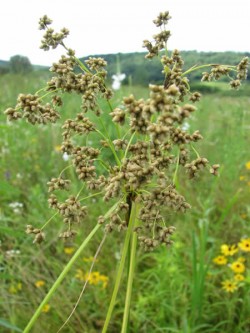 Woolgrass
Woolgrass
Scirpus cyperinus
Description: Erect, grass-like perennial. Lacking roots, uses a fibrous root system, forming individual tufts for roots.
Inflorescence: Flowers occur in dense, rounded clusters of greenish-brown spiky stems that rise from the top of the main stem. Fruits’ colors range from yellow-gray to white.
Leaves: Leaves are smooth, flat, elongated, and up to an inch wide.
Height: 4-5′.
Ecology: Very rarely a dominant plant, individuals are most often scattered over an area.
Growth Requirements: Grows in areas that are either saturated or moist all year round, but doesn’t tolerate more than a couple inches of standing water. Prefers full to partial sun, and sandy soils.
Ethonobotany: Woolgrass stems were woven to make matting and ropes. The fruiting tops of the plant were used as a resilient material for stuffing and making pillows. The small rushes were used in making woven mats and storage bags.
 Softstem Bulrush; Common Great Bulrush
Softstem Bulrush; Common Great Bulrush
Scirpus validus
Description: Slender, perennial aquatic plant, with pale green, round, spongy and easily crushable stems.
Inflorescence: Branched reddish-brown clusters, found at the base of an erect, green bract; typically has many stems. Mostly at stem base, most reduced to bladeless sheaths.
Leaves: Leaves are primarily at the stem base, reduced to sheaths.
Height: to 9′.
Ecology: The seeds of this species are a preferred food of ducks and other waterfowl. The dense growth also provides excellent cover for a variety of species, especially in association with cattail. Spreads both vegetatively and by seed. Seed will remain viable in the soil for up to 20 years.
Growth Requirements: Prefers poorly drained or continuously saturated soil, standing or slowly moving water, and will grow in up to 10 inches of water. Tolerates saline and alkaline soils. This species is highly recommended for wetland restoration because it can triple its biomass annually.
Ethnobotany: The dried beaten rootstocks were used by some native peoples as meal for bread, while the young tip of the rootstock was edible and reputed to serve as a thirst-quencher. The boiled young roots yield sweet syrup.
 Small-fruited Bulrush
Small-fruited Bulrush
Scirpus microcarpus
Description: Robust plant with abundant, stout, triangular stems.
Inflorescence: Produces clusters of small, brown flowers at the end of secondary stems.
Leaves: Flat, grass-like leaves that are light green in color.
Height: Grows 2-5′ high.
Ecology: Small-fruited bulrush is widespread in wetlands throughout the Pacific Northwest. Seeds, rhizomes, and shoots are eaten by waterfowl and muskrats.
Growth Requirements: Tolerates wide range of soil regimes, prefers sites that are wet all but a few months of the year. An aggressive, fast grower, it has done very well at steam restoration sites on the Palouse. Shade intolerant.
Ethnobotany: Leaves from this species were used to wrap foods for cooking. Used to make fringe for buckskin dresses by the Okanagan-Colville Indians. used to cut a newborn babies’ umbilical cord by Thompson Indians.
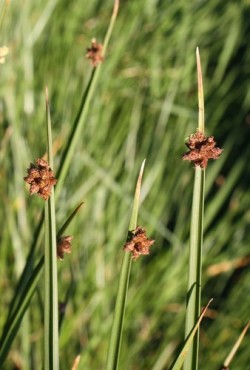 Three-square Bulrush
Three-square Bulrush
Scirpus pungens, Scirpus americanus, Schoenoplectus americanus
Description: Triangular stems in loose groupings.
Leaves: Firm, strongly folded dark-brown leaves with seeds inside.
Height: 4-6′
Ecology: The rhizomes of this species are preferred by muskrats and geese, and the seeds are eaten by waterfowl. The stems also provide habitat for birds and small mammals.
Growth Requirements: Thrives in wet soil on the edges of ponds, lakes, and streams. Will grow in standing water up to 12 inches deep Tolerant of moderate alkalinity. Medium salinity tolerance.
Ethnobotany: The seeds are rich in protein and can be ground and added to flour. The flour can also be mixed with water, boiled, and eaten as a mush. Leaves of this species have been woven into baskets and hats. Allegedly when mixed with oil and rubbed on ones’ head, the leaves will make ones’ hair grow long and thick.
 Common Cattail
Common Cattail
Typha latifolia
Description: Aggressive, hardy plant, usually forming dense, extensive patches. Perennial.
Inflorescence: Tiny, dense flowers clustered on a spike at the end of the stem. The flowers begin green, and are brown when ripe.
Leaves: Long and slender, with a spongy feel to the touch.
Height: 5-7′
Ecology: Often the dominant plant at the fringes of ponds and ditches, sometimes growing so densely as to be a nuisance. Provides cover for wild ducks, geese, and other gamebirds, and house building material for muskrats. Cattails are known to have excellent natural water filtering qualities.
Growth Requirements: Cattails can be germinated from seeds but the plants will remain small for 2-3 years. They are more effectively propagated by root division. Cattails thrive in damp soil in up to 10 inches of water at low to mid elevations. They don’t tolerate flowing water, however.
Ethnobotany: Cattail rhizomes were eaten by Native Americans. Stems and leaves were woven into mats. “Fluff” was used for stuffing pillows and mattresses. The flower head can be eaten like corn-on-the-cob when green. The sticky juice from the leaves may be rubbed on the gums to relieve toothaches.
